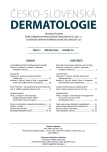-
Medical journals
- Career
Hereditary Ichthyoses
Authors: B. Pinková 1; H. Bučková 1; R. Borská 2; L. Fajkusová 2
Authors‘ workplace: Dětské kožní oddělení Pediatrické kliniky, LF MU a FN Brno primář MUDr. Hana Bučková, Ph. D. 1; Centrum molekulární biologie a genové terapie IHOK FN Brno a LF MU v Brně vedoucí pracoviště doc. RNDr. Lenka Fajkusová, Ph. D. 2
Published in: Čes-slov Derm, 91, 2016, No. 1, p. 3-12
Category: Reviews (Continuing Medical Education)
Overview
Hereditary ichthyoses form a very heterogeneous group of disorders manifested by dry, rough and scaly skin. An impairment of cutaneous barrier, to various degrees, is present in all forms of ichthyoses. Hereditary ichthyoses are caused by different gene mutations. Clinical manifestations of individual types of ichthyosis change during patient’s life. The authors are currently engaged in the diagnosis and classification of congenital ichthyosis based on molecular diagnostics and they emphasize the importance of comprehensive genetic counseling and genetic prevention. Patients should be followed up in specialized centers. Recently developing patient organization represents a great benefit for the patients.
Key words:
ichthyosis – diagnostics – DNA molecular analysis
Sources
1. AKIYAMA, M., SHIMIZU, H. An update on molecular aspects of the non-syndromic ichthyoses. Experimental Dermatology, 2008, 17, p. 371–382.
2. BRECHER, A. R., ORLOW, S. I. Oral retinoid therapy for dermatologic conditions in children and adolescents. Journal of American Academy of Dermatology, 2003, 49, p. 171–182.
3. DI GIOVANNA, J. J., BALE, S. J. Clinical heterogenity in epidermolytic hyperkeratosis. Archives of Dermatology, 1994, 130, p. 1026–1035.
4. ELIAS, P. M., WILLIAMS, M. L., CRUMRINE, D., SCHMUTH, M. Ichthyoses, clinical, biochemical, pathogenic and diagnostic assessment. Current problems in dermatology, 2010, 39.
5. FERNANDES, N. F., JANNINER, C. K., SCHWARTZ, R. A. X-linked ichthyosis: an occulocutaneous genodermatosis. Journal of American Academy of Dermatology, 2010, 62, p. 480–485.
6. HÖGER, P. Kindermatologie – differenzialdiagnostik und Therapie bei Kindern und Jugendlichen. 3. vollständing überarbeitete und erweiterte Auflage, 2011, ISBN 978-3-7945-2730-4.
7. KOMATSU, N., TAKATA, M., OTSUKI, N., OHKA, R. Elevated stratum corneum hydrolytic activity in Nethertone syndrome suggests an inhibitory regulation of desquamation by SPINK 5 derived peptides. Journal of Investigative Dermatology, 2002, 118, p. 436–443.
8. KRUG, M., OJI, V., TRAUPE, H., BERNEBURG, M. Ichthyosen – Teil 1: Differentialdiagnose Vulgärer Ichthyosen und therapeutische Erwägungen. Journal Deutscher Dermatologischer Gesellschaft, 2009, 7, p. 511–520.
9. LACOUR, M., MEHTA - NIKHAR, B., ATHERTON, D., HARPER, J. I. An appraisal of acitretin therapy in children with inherited disorders of keratinization. British Journal of Dermatology, 1996, 134, p. 1023–1029.
10. OJI, V., TADINI, G., AKIYMA, M., BLANCHET BARDON, C., BODEMER, C., BOURRAT, E., COUDIERE, P., DIGIOVANNA, J. J., ELIAS, P., FISCHER, J., FLECKMAN, P., GINA, M., HARPER, J., HASHIMOTO, T., HAUSSER, I., HENNIES, H. C., HOLS, D., HOVNANIAN, A., ISHIDA – YAMAMOTO, A., JACYK, W. K., LEACHMAN, S., LEIGH, I., MAZEREEUW-HAUTIER, J., MILSTONE, L., MORICE-PICARD, F., PALLER, A. S., RICHARD, G., SCHMUTH, M., SHIMIZU, H., SPRECHER, E., VAN STEENSEL, M., TAIEB, A., TORO, J. R., VABRES, P., VAHLQUIST, A., WILLIAMS, M., TRAUPE, H. Revised nomenclature and classification of inherited ichthyoses: results of the First Ichthyosis Consensus Conference in Sorèze 2009. Journal of American Academy of Dermatology, 2010, 63, 4, p. 607–641.
11. OJI, V., TRAUPE, H. Ichthyoses: differential diagnosis and molecular genetics. European Journal of Dermatology, 2006, 16, p. 349–359.
12. ORMEROD, A. D., CAMPALANI, E., GOODFIELD, M. I. BAD Clinical standards Unit British Association of dermatologist guidelines on efficacy and use of acitretin in dermatology. British Journal of Dermatology, 2010, 162, p. 952–963.
13. PREIL, M. L., TRAUPE, H. Diagnostik und Therapie der Ichthyosen. AWMF - Leitlinie , 2008, 9, Nr.13/043.
13. STRYK, S., SIEGFRIED, E. C., KNUSTON, A. P. Selective antibody deficiency to bacterial polysacharide antigens in patients with Netherton syndrome. Pediatric Dermatology, 1999, 16, p. 19–22.
14. VAHLQUIST, A., GANEMO, A., VIRTANEN, M. Congenital ichthyoses: an overview of current and emerging therapies. Acta Dermato – Venereology, 2008, 88, p. 4–14.
15. WALLEY, A. J., CHAVANAS, S., MOFFATT, M. F., ESROUF, R. M., WONG, K., HARPER, J. I. Gene polymorfismus in Nethertone syndrome and common atopic diseases. Nature Genetics, 2001, 29, p. 175–178.
16. WEIDINGER, S., O´SULLIVAN, M., ILLIG, T., BARNETT, H., DEPNER, M., RODRIGUEZ, E., RUETHER, A., KLOPP, N., VOGELBERG, C., WEILAND, S. K. Filaggrin mutation, atopic eczema, hay fever and asthma in children. Journal of Allergology and Clinical Immunology, 2009, 121, p. 1203–1209.
Labels
Dermatology & STDs Paediatric dermatology & STDs
Article was published inCzech-Slovak Dermatology

2016 Issue 1
Most read in this issue- Hereditary Ichthyoses
- Congenital Dermatofibrosarcoma Protuberans
- Psoriasis, Psoriatic Arthritis and Tophaceous Gout
Login#ADS_BOTTOM_SCRIPTS#Forgotten passwordEnter the email address that you registered with. We will send you instructions on how to set a new password.
- Career

